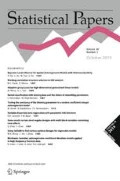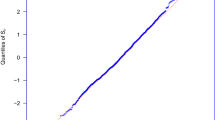Abstract
In this paper, the Berry–Esseen type bounds of the weighted estimator in a nonparametric regression model are investigated under some mild conditions when random errors are from a linear process generated by \(\varphi \)-mixing random variables. In particular, the rate of uniform normal approximation is near to \(O(n^{-\frac{3}{16}})\) by the choice of some constants, which generalizes and improves the corresponding results of Li et al. (Stat Probab Lett 81:103–110, 2011) and Ding et al. (J Inequal Appl 2018:10, 2018). Finally, the simulation study is provided to verify the validity of the theoretical results.












Similar content being viewed by others
References
Babu GJ, Ghosh M, Singh K (1978) On rates of convergence to normality for \(\varphi \)-mixing processes. Sankhya A 40(3):278–293
Billingsley P (1968) Convergence of probability measures. Wiley, New York
Chen X (2012) Asymptotic properties for estimates of nonparametric regression model with martingale difference errors. Stat J Theor Appl Stat 46(5):687–696
Chen PY, Hu TC, Volodin A (2009) Limiting behavior of moving average processes under \(\varphi \)-mixing assumption. Stat Probab Lett 79:105–111
Chen ZY, Wang HB, Wang XJ (2016) The consistency for the estimator of nonparametric regression model based on martingale difference errors. Stat Pap 57(2):451–469
Ding LW, Chen P, Li YM (2018) Berry-Esseen bounds of weighted kernel estimator for a nonparametric regression model based on linear process errors under a LNQD sequence. J Inequal Appl 2018:10
Dobrushin RL (1956) The central limit theorem for non-stationary Markov chain. Theory Probab Appl 1:72–88
Georgiev AA (1985) Local properties of function fitting estimates with applications to system identification. In: Grossmann W, Pflug G, Vincze I, Wertz W (eds) Mathematical statistics and applications. Proceedings of the 4th Pannonian symposium on mathematical statistics, 4–10 (September 1983), Bad Tatzmannsdorf, Austria. Riedel, Dordrecht, pp 141–151
Hu SH, Wang XJ (2008) Large deviations for some dependent sequences. Acta Math Sci B 28(2):295–300
Kiesel R (1998) Strong laws and summability for \(\varphi \)-mixing sequences of random variables. J Theor Probab 11(1):209–224
Kim TS, Ko MH (2008) Complete moment convergence of moving average processes under dependence assumptions. Stat Probab Lett 78:839–846
Kumar P (1972) On the Bahadur representation of sample quantiles for sequences of \(\phi \)-mixing random variables. J Multivar Anal 2:77–95
Li YM, Yin CM, Wei CD (2008) The asymptotic normality for \(\varphi \)-mixing dependent of wavelet regression function estimator. Acta Math Appl Sin A 31(6):1046–1055
Li YM, Wei CD, Xing GD (2011) Berry-Esseen bounds for wavelet estimator in a regression model with linear process errors. Stat Probab Lett 81:103–110
Liang HY, Fan GL (2009) Berry-Esseen type bounds of estimators in a semiparametric model with linear process errors. J Multivar Anal 100(1):1–15
Liang HY, Jing BY (2005) Asymptotic properties for estimates of nonparametric regression models based on negatively associated sequences. J Multivar Anal 95(2):227–245
Liang HY, Li YY (2008) A Berry-Esseen type bound of regression estimator based on linear process errors. J Korean Math Soc 45(6):1753–1767
Liang HY, Li DL, Miao TX (2016) Berry-Esseen type bound of conditional mode estimation under truncation and strong mixing assumptions. Commun Stat Theory Methods 45(17):5077–5097
Liu YX, Niu SL, Liang HY (2017) Berry-Esseen bounds of recursive kernel estimator of density under strong mixing assumptions. Bull Korean Math Soc 54:343–358
Lu CR, Lin ZY (1997) Limit theory for mixing dependent sequences. Science Press of China, Beijing
Petrov VV (1995) Limit theory for probability theory. Oxford University Press, New York
Roussas GG, Tran LT, Ioannides DA (1992) Fixed design regression for time series: asymptotic normality. J Multivar Anal 40(2):262–291
Shen AT (2016) Complete convergence for weighted sums of END random variables and its application to nonparametric regression models. J Nonparametric Stat 28(4):702–715
Shen AT, Wang XH, Ling JM (2014a) On complete convergence for non-stationary \(\varphi \)- mixing random variables. Commun Stat Theory Methods 43(22):4856–4866
Shen AT, Wang XH, Li XQ (2014b) On the rate of complete convergence for weighted sums of arrays of rowwise \(\varphi \)-mixing random variables. Commun Stat Theory Methods 43(13):2714–2725
Shen AT, Zhang Y, Volodin A (2015) Applications of the Rosenthal-type inequality for negatively superadditive dependent random variables. Metrika 78(3):295–311
Tran L, Roussas G, Yakowitz S, Truong VB (1996) Fixed design regression for linear time series. Ann Stat 24(3):975–991
Utev SA (1990) The central limit theorem for \(\varphi \)-mixing arrays of random variables. Theory Probab Appl 35(1):131–139
Wang XJ, Si ZY (2015) Complete consistency of the estimator of nonparametric regression model under ND sequence. Stat Pap 56(3):585–596
Yang SC (1995) Almost sure convergence of weighted sums of mixing sequence. J Syst Sci Math Sci 15(3):254–265
Yang SC, Li YM (2006) Uniformly asymptotic normality of the regression weighted estimator for strong mixing samples. Acta Math Sin (Chin Ser) 49(5):1163–1170
Yang WZ, Wang XJ, Li XQ, Hu SH (2012) Berry-Esseen bound of sample quantiles for \(\varphi \)-mixing random variables. J Math Anal Appl 388:451–462
Zhou XC (2010) Complete moment convergence of moving average processes under \(\varphi \)-mixing assumptions. Stat Probab Lett 80(5–6):285–292
Author information
Authors and Affiliations
Corresponding author
Additional information
Publisher's Note
Springer Nature remains neutral with regard to jurisdictional claims in published maps and institutional affiliations.
Supported by the National Natural Science Foundation of China (11671012, 11871072, 11701004, 11701005), the Natural Science Foundation of Anhui Province (1808085QA03,1908085QA01), the Provincial Natural Science Research Project of Anhui Colleges (KJ2017A027, KJ2018B16), the Scientific Research Foundation Funded Project of Chuzhou University (2018qd01) and the Scientific Research Project of Chuzhou University (2015PY01, 2017qd16).
Appendix
Appendix
Lemma A.1
(cf. Liang and Fan 2009, Lemma 3.1) Let X and \(Y_1,Y_2,\ldots ,Y_m\) be random variables. Then for positive numbers \(a_1,a_2,\ldots ,a_m\), we have
Lemma A.2
(cf. Lu and Lin 1997, Lemma 1.2.8) Let \(\{X_n,n\ge 1\}\) be a sequence of \(\varphi \)-mixing random variables. Let \(X\in L_p({\mathcal {F}}_1^{k})\), \(Y\in L_q({\mathcal {F}}_{k+n}^{\infty })\), \(p\ge 1\), \(q\ge 1\) and \(1/p+1/q=1\). Then
Lemma A.3
(cf. Petrov 1995, Theorem 5.7) Let \(X_1,X_2,\ldots ,X_n\) be independent random variables with \(EX_j=0\) and \(E|X_j|^{2+\delta }<\infty \) for some \(0<\delta \le 1\) and \(j=1,2,\ldots ,n\). Denote \(B_n=\sum \nolimits _{j=1}^n \text {Var} X_j\), then
Lemma A.4
(cf. Yang 1995, Lemma 2) Let \(\{X_n,n\ge 1\}\) be a sequence of \(\varphi \)-mixing random variables with \(EX_j=0\). If \(\sum \nolimits _{j=1}^{\infty }\varphi ^{1/2}(j)<\infty \) and \(E|X_j|^q<\infty \) for \(q\ge 2\) and \(j=1,2,\ldots \), then for each \(n\ge 1\),
Lemma A.5
(cf. Li et al. 2008, Lemma 3.4) Let \(\{X_n,n\ge 1\}\) be a sequence of \(\varphi \)-mixing random variables. Suppose that p and q are two positive integers. Set \(\eta _l=:\sum \nolimits _{j=(l-1)(p+q)+1}^{(l-1)(p+q)+p}X_j\) for \(1\le l\le k\). Then
Proof of Lemma 5.1
It follows from the definition of \(S_{1n}^{''}\), Lemma A.4, \(Ee_0^2<\infty \) and (\(A_1\))–(\(A_4\)) that
Similar to (6.1), we have
and
This completes the proof of Lemma 5.1. \(\square \)
Proof of Lemma 5.2
It is easy to see that
thus,
Noting that \(ES_n^2=1\), we have
Hence, by \(C_r\) inequality, Hölder’s inequality, \(ES_n^2=1\) and Lemma 5.1, we have
From Lemma A.2, (\(A_1\)), (\(A_4\)) and (\(A_2\)), we have
Therefore, the desired result follows from (6.5) and (6.6) immediately. \(\square \)
Proof of Lemma 5.3
By Lemma A.3, we have
According to Lemma A.4, (\(A_1\)), (\(A_2\)) and (\(A_4\)), it follows that
Combined with (6.7) and Lemma 5.2, the proof of Lemma 5.3 is completed. \(\square \)
Proof of Lemma 5.4
Let \(\phi (t)\) and \(\psi (t)\) be the characteristic functions of \(S_{1n}^{'}\) and \(T_n\), respectively. By Esseen inequality (see Petrov 1995, Theorem 5.3), for any \(T>0\), we have
It can be found by Lemma A.5, (\(A_1\)), (\(A_2\)) and (\(A_4\)) that
Thus, \(L_{1n}\le C\gamma _{4n}T\). It is easily seen by Lemmas 5.3 and 5.2 that
Hence, \(L_{2n}\le C(\gamma _{2n}^{\delta /2}+\frac{1}{T}).\) By choosing \(T=\gamma _{4n}^{-1/2}\), we can obtain that
This completes the proof of the lemma. \(\square \)
Proof of Lemma 5.5
It follows by Lemma A.4, (\(A_1\))–(\(A_4\)) that
Similarly, we have
Thus, according to Markov’s inequality, (6.9), (6.10) and (6.3), we have
and
The proof is completed. \(\square \)
Rights and permissions
About this article
Cite this article
Deng, X., Wang, X. & Wu, Y. The Berry–Esseen type bounds of the weighted estimator in a nonparametric model with linear process errors. Stat Papers 62, 963–984 (2021). https://doi.org/10.1007/s00362-019-01120-z
Received:
Revised:
Published:
Issue Date:
DOI: https://doi.org/10.1007/s00362-019-01120-z




